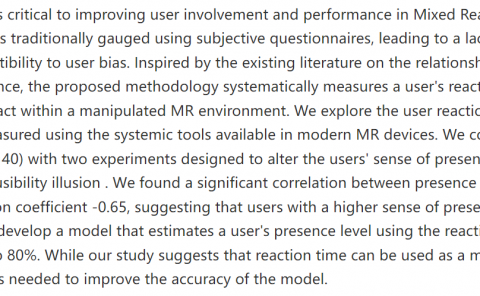Auditory and Olfactory Stimuli-Based Attractors to Induce Reorientation in Virtual Reality Forward Redirected Walking
PubDate: April 2022
Teams: Gwangju Institute of Science and Technology
Writers: Jieun Lee;Seokhyun Hwang;Kyunghwan Kim;SeungJun Kim

Abstract
Redirected walking (RDW) visually manipulates the virtual environment to imperceptibly redirect the walkers to keep them in the tracking area, and offers a larger space than physical space. An attractor is a redirected walking technique that captures the walker’s attention and manipulates the walker’s trajectory through rotational gain. However, the attractor visually manipulates the walker’s virtual environment using a predefined rotational gain, and having to constantly gaze at the attractor or the attractor frequently appearing until the walker’s direction matches the desired direction, are problems limiting the application of visual attractors. Moreover, when the walker is unable to recognize or ignores the attractor, reorientation fails. In this study, we designed a human-sense-stimulating attractor that utilizes the auditory and olfactory senses to improve the rotational gain, naturalness, and immersion and decrease the chance of reorientation failure. Although sound and scents are invisible, they can be detected through direction; however, humans cannot recognize the accurate direction of a sound or scent. Based on these characteristics, auditory and olfactory attractors are proposed. We measured the amount of reorientation induced by the auditory and olfactory attractors and calculated the reorientation success rate. Additionally, the naturalness and immersion of the attractor were evaluated. The auditory attractor has a high reorientation success rate, naturalness, and immersion. The olfactory attractor induces more turn changes in the walker than other attractors, and a high number of turn changes leads to a larger rotational gain. Auditory and olfactory-based attractors have the potential to overcome the shortcomings of visual attractors such as the frequent interventions.


